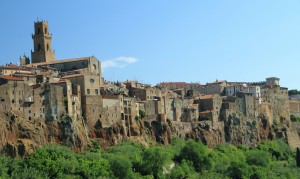When you see Pitigliano, it’s like turning the pages of a book of fairy tales set in the Middle Ages. The town is built on a promontory surrounded by bright green valleys, grooved by the Lente and Meleta rivers. The high tufa cliffs are chiseled with a thousand caves and tower-houses. The houses are built on a tufaceous drum in the same jutting vertical as the sheer cliffs which make the city wall almost superfluous.
This, however, in no way detracts from the splendid military structures such as the 13th Orsini palace. The town takes pride in its heritage: the Prehistoric period, with its tombs discovered along the city wall and in the surrounding area; the Roman period that left behind the town’s name, Gens Petilia; the Medieval period of the Aldobrandeschi, lords of the Maremma for almost five hundred years; the Renaissance grandeur brought by the noble Roman family, the Orsini; and, after a brief Sienese interlude, the Medici and their heirs, the Lorraine who stimulated a phase of modernization.
Another key to the appreciation of Pitigliano is the famous Jewish ghetto. This extraordinary town has been called “Little Jerusalem” because of its large and active Jewish population that settled there beginning in the 15th century. Today the Synagogue is once again open to the public, both for worship and a visit, after extensive restoration. The interesting Jewish Cemetery, the unleavened bread oven, the cellar carvedinto the rock where Kosher wine is produced, the Kosher butcher, the cleansing baths for women and the cleaners are all open to the public.
The town is surrounded by important archaeological sites, from the ancient vie cave to the various necropoleis and primitive villages. Without doubt, the most important necropolis is Poggio Buco, the largest Etruscan centre on the Fiora. In addition to the remains of the original city, numerous varieties of tombs have been discovered, among which the monumental cliff tombs such as the Tombadelta Regina (the Queen’s Tomb). The wine production is another good reason to visit this land.The vineyards, fertilized by volcanic tufa and thousand year old humus, produce prestigious white DOC wines. The caves and tombs cut intothe tufa rock are used as cellars for the wines’ preservation and aging. The olive oil as well, produced by cold pressing, has few rivals on the national and international scene.

0 Comments